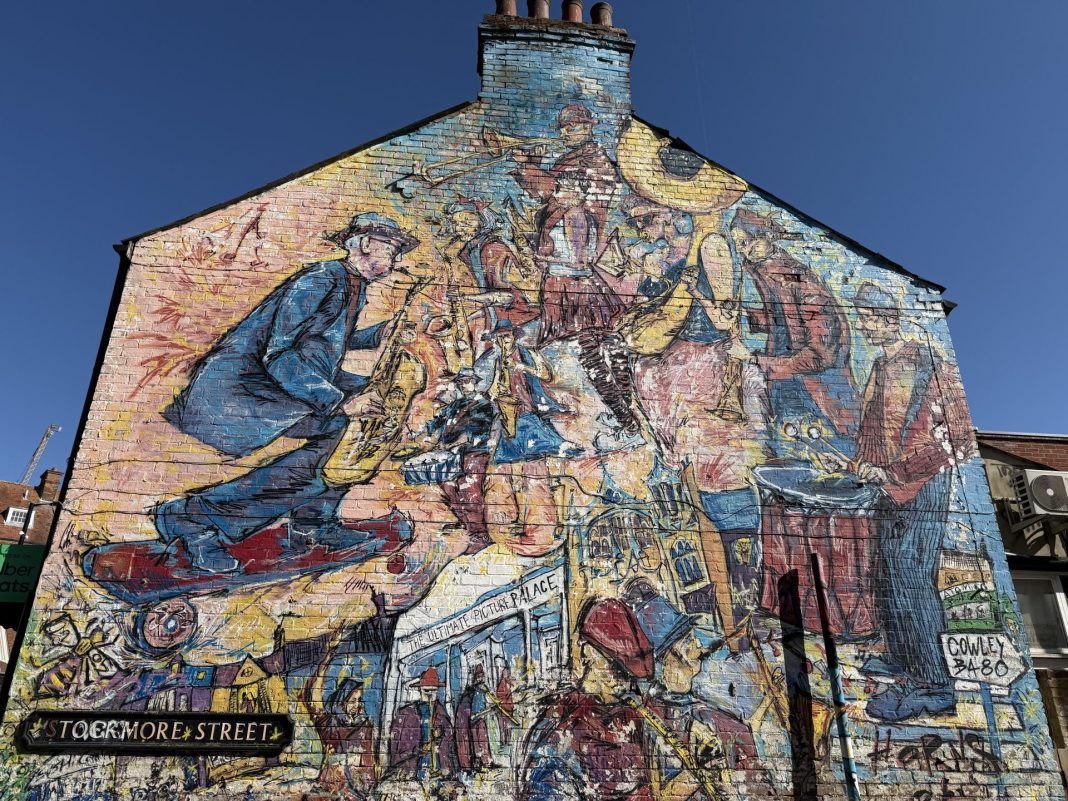Just a five-minute stroll from the imposing spires of Magdalen College lies Cowley Road, the heart of Oxford’s urban culture. Oxford, renowned for its grand dining halls and neoclassical facades, is not a place where street art is the first thing that comes to mind. Yet, beyond the grandeur, Cowley Road transforms brick and concrete into a vibrant canvas – capturing the city’s community and vitality in bold, defiant strokes.
A striking example is the mural on Stockmore Street, just off Cowley Road, depicting Horns of Plenty (pictured above) – a community street band formed in East Oxford in 2007. Commissioned for their tenth anniversary and the Cowley Road Carnival in 2017, the piece was created with support from Oxford City Council.
This mural, created by renowned local street artist Andrew Manson (known as Mani) radiates the community’s energy. Its striking contrast of cool blues and fiery reds demands our attention, while its towering presence makes it impossible to miss.
The band dominates the composition, their large figures placed at the top centre, making up over half of the scene. On the top left, one member plays the saxophone while skateboarding, while on the far right, another drums, while crossing the road, adding a playful, lively energy to the scene.
Beneath the band, vibrant shops line the scene, with more musicians scattered throughout, playing saxophones and drums, their lively energy mirrors the booming sounds of Cowley Road’s Carnival. The overlapping figures and surroundings further emphasize the city’s bustling atmosphere during this time.
A closer look at this piece – now far from the vibrant freshness it once had – reveals peeling paint and signs of decay, a quiet reminder of life’s transience. Like the carnival it depicts, the artwork will fade away with time, surviving vividly in the memories of those who saw it. The exposed brick beneath grounds it in the city’s fabric, reinforcing its connection to urban life.
Street art now contributes to Cowley Road’s vibrant energy, but it wasn’t always so revered. Originating from illegal graffiti, street art formerly faced widespread criticism. However, local artists like the Mes Crew (Must One and Seven) have collaborated with councils and the community to establish the Open Walls Network – legal spaces around Oxford, including tunnels and walls, for artists to showcase their work.
The Mes Crew has also created stunning works around Oxford, including the vibrant redesign of The Library pub on Cowley Road in summer 2024. This piece features a range of characters from books by renowned authors with ties to Oxfordshire.
On the bottom right you’ll find the Cheshire Cat with his mischievous grin, alongside Absolem, with his signature pipe, from Alice and Wonderland by Lewis Carrol, who studied mathematics at the University of Oxford.To the top right is the iconic Cat from Dr. Seuss’s The Cat in the Hat. Dr Seuss himself completed his postgraduate degree at Lincoln college, Oxford.
Above the sign, the White rabbit from Alice and Wonderland appears alongside the Witch from C.S Lewis’ Chronicles of Narnia – Lewis himself an alumnus of Magdalen College, Oxford. At the bottom, a scene from J.R.R Tolkien’s The Lord of the Rings pays tribute to the renowned author, who was both an Oxford professor and a close friend of C.S Lewis.
Another striking piece of street art in Cowley is a mural of the Radcliffe Camera, created by renowned street artist Reeves One in collaboration with the Oxford Street Art Collective. Painted during the 2017 Cowley Road Carnival, it can be found on Moberly Close, just off Cowley Road. The mural reimagines one of Oxford’s most iconic buildings in a bold contemporary style.
Set against a mysterious purple background, the Radcliffe Camera is rendered in vivid, unexpected colours – yellow-tinted windows and a turquoise dome – that reimagines its classical form with a bold, industrial aesthetic. The striking palette creates a powerful contrast between tradition and modernity.
The dome appears to hover, with machine-like elements emerging from both the top and base. These details suggest a fusion of past and present: the classical architecture merges with an industrial, futuristic vision, reflecting the changing nature of art and design.
This mural creates a visual dialogue between Oxford’s classical heritage and its dynamic street art scene, celebrating the coexistence of tradition and evolving creative culture.
Street art in Oxford is a powerful reflection of the city’s energy and culture. So next time you think of art in Oxford, don’t just picture the ornate ceiling of the Radcliffe Camera or the marble sculptures of the Ashmolean – consider the street art, created by and for the community. Unlike the permanence of Oxford’s historic buildings, its beauty lies in its ever-changing nature, a vibrant symbol of modernity.


